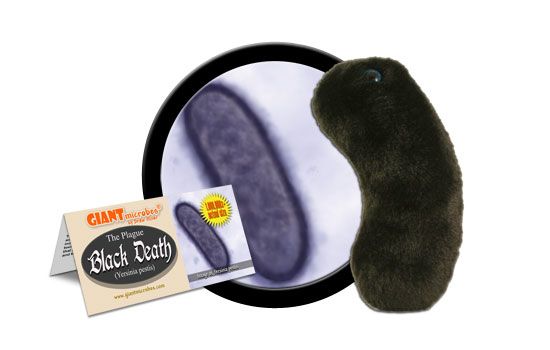Black Death (Yersinia pestis)
Product Details
Additional Information
| Sizes | Giantmicrobes are based on actual microbes, cells, organisms and other critters, only 1,000,000 times actual size! Gigantic (GG) 16-24" XL (XL) 10-15" Original (PD) 5-8" Keychain (KC) 2-4" with clip |
|---|---|
| Materials | Plush from all new materials. Stuffed with polyester fiber fill. Surface washable: sponge with water & soap, air dry. |
| Packaging | Each plush microbe includes a printed card with fun, educational and fascinating facts about the actual microbe or cell. |
| Safety | Every product meets or exceeds U.S. and European standards for safety. For ages 3 and up. |
All about Black Death (Yersinia pestis)
FACTS: In October, 1347, the Black Death (then called the “pestilence”) arrived in the city of Messina in Sicily. The plague, which had been raging in Asia, had followed the trade routes and stowed away on ships returning from the Black Sea. By 1352, 25 million people – or a third of Europe’s population – were dead.
This was at least the second instance of a cataclysmic plague striking Europe. In 542 A.D., the plague ravaged the Roman empire of Justinian (and the plague may have been responsible for devastating Athens in 430 B.C.). During yet another wave of plague in 1894 in Asia, a Swiss-French bacteriologist named Alexandre Yersin discovered that the Yersinia pestis bacterium was the devil behind it. (Although some have questioned whether this bacterium was responsible for the medieval Black Death – the spread of which was uncommonly rapid – the consensus continues to favor Yersin.)
The plague has not been eradicated. But outbreaks today are few and isolated. In addition, there are readily available treatments, including the antibiotic Tetracycline (commonly prescribed to teenagers with severe acne). Nevertheless, it is always possible that antibiotic-resistant strains could one day become prevalent and that history could repeat itself again….
| Name | The microbe was named after the first man to describe it. The disease, bubonic plague, gets its name from the characteristic buboes that form when lymph nodes swell and burst. It’s also known as black death because it causes gangrene, which is characterized by black hands and feet. |
|---|
| Actual Size | One microbe is about 0.5 to 1m. That’s 10 times smaller than a strand of hair! |
|---|
| Where It Lives | The Bubonic Plague, or Black Death, is caused by a rod-shaped bacteria called Yersinia pestis. This microbe lives and multiplies inside rodents like rats, squirrels, and mice. It can spread to humans through infected flea bites, contaminated objects, or inhaling aerosolized bacteria. |
|---|
| Symptoms | Fever, chills, headache, malaise, and buboes. |
|---|
| Cure | Intravenous antibiotics for 10 to 14 days. |
|---|
| History |
1894: First described by Alexandre Yersin. Big Outbreaks: 541 A.D.: A pandemic that started in Egypt lasted 150 years and wiped out 60% of the population in North Africa, parts of Asia, and Europe! 1330: Asia Pandemic that spread to Europe killed about 75 million people. That’s twice the population of California! Recent Outbreaks: 2003: Most recent case reported in the U.S. |
|---|
| Fascinating Facts |
Even though treatment is available today, Y. pestis is considered to be a bioterrorism agent due to the history of causing pandemics. Y. pestis has a distinct “safety-pin” appearance when stained and observed under the microscope. Famous people who died of it: 429 BCE: Pericles, a famous Greek statesman and General that lived during the Golden Age of Athens. 1596: William Shakespeare’s son, Hamnet, died at age 11. 1710: Anne of Bohemia, Queen of England. |
|---|






